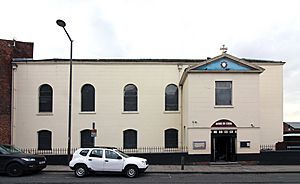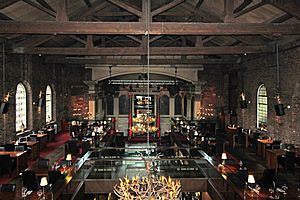St Peter's Roman Catholic Church, Liverpool facts for kids
St. Peter's Roman Catholic Church was once a church in Liverpool, England. It was later changed into a restaurant and bar called Alma de Cuba, which means "the soul of Cuba" in Spanish. On 14 November 2024, the building opened again as St Peter's Tavern.
For many years, St. Peter's was the oldest Catholic Church in Liverpool. It is a special building, listed as Grade II, which means it is important and protected.
In September 2024, a company called The 1936 Pub Company bought the building. They planned to fix it up and open it as St Peter's Tavern.
Contents
History of St. Peter's Church
Here are some important moments in the history of St. Peter's:
- 1788: St Peter's Church opened on September 7. A newspaper reported that a new Catholic chapel in Seel Street had its first service.
- 1789: The city gave a special lease for the church land. This meant it could be a place of worship for a very long time.
- 1814: Father Archibald Benedict McDonald, who started the church, passed away. He was 78 years old and had been the church's leader for 26 years.
- 1817-1818: The church building was made bigger. A porch and a gallery (an upper floor for seating) were added.
- 1817: St Peter's Schools opened. This was one of the first Catholic schools in the area.
- 1845: The church had a major expansion. Part of the priests' house next door was joined to the church. This created the Sanctuary, which is the area around the altar.
- 1847: Many Irish people came to Liverpool to escape a terrible famine. A serious illness called typhus spread. Father James Francis Appleton, a priest at St. Peter's, died from typhus while helping sick people.
- 1854: The last burial took place in the church's underground vaults.
- 1864: The Lady Chapel was built. This was done to remember Father Benedict Bonney.
- 1872: Father Scarisbrook became a Bishop at a special ceremony held in St. Peter's.
- 1898: A new altar for the Lady Chapel was put in. This celebrated Father Anderson's 50 years in the Benedictine Order.
- 1920: Electric lights were put in the church for the first time. The church was also redecorated.
- 1934: A count showed that 2,823 Catholic people lived in the church's parish area.
- 1938: St Peter's celebrated its 150th birthday! Many people attended a special Mass. The streets around the church were decorated for this big event.
- 1940-1941: During World War II, Liverpool was bombed a lot in what was called the Blitz. St. Peter's was damaged several times.
- 1976: The church was given to the Polish community for a short time.
- 1978: The church parish closed, and the building was not used for a while.
- 1993: The church was officially "deconsecrated." This means it was no longer used as a church.
- 2003: Plans were approved to turn the old church into offices.
- 2004: Workers found the bodies of priests and other people in the church's crypt (an underground burial place). Seven monks were later reburied at Ampleforth Abbey. The church's founder, Father McDonald, was reburied in Ford Cemetery.
- 2005: A bar and restaurant called Alma de Cuba opened in the building.
- 2024: The building reopened as St Peter's Tavern.
St. Peter's During the Blitz
St. Peter's Church was hit and damaged many times during the Blitz in 1940 and 1941. The Blitz was a time when German planes bombed British cities during World War II.
Father Louis D’Andria, a priest at St. Peter's, wrote letters about the damage. In one letter from December 1940, he described how doors were blown in and there were holes in the roof. He also mentioned a big stone that had come through a skylight.
In May 1941, Father D’Andria wrote that the church roof was on fire. He and other priests had to quickly move important church records to safety. The church was so damaged that it had to close. Services were held at a nearby convent instead.
The priests' house next to the church was also badly damaged. The top floor was completely destroyed. It took a long time to get repairs done after the war. Documents show that getting builders to fix the church and house was difficult.
During the Liverpool Blitz in May 1941, nearly 1,750 people in Liverpool died. About 90,000 houses were destroyed, and many people lost their homes. Areas close to St. Peter's were heavily damaged.
How St. Peter's Began
Before St. Peter's, Catholic churches in Liverpool faced many challenges. In the early 1700s, Catholic services were often held secretly. The first Catholic chapel in Edmund Street was built in 1736. But it was destroyed by angry crowds in 1746.
Later, a new chapel was built disguised as a warehouse. Catholics had to meet quietly in people's homes to worship.
In 1783, Father Archibald MacDonald became a priest at St. Mary's, another Catholic mission. He was the one who founded St. Peter's Church in 1788. When he chose the spot for the new church, it was quite far out of town. His leaders thought it was too far, but St. Peter's was built there anyway.
Inside the old church, there were white marble memorials for priests who had served there. One memorial was for Father Archibald MacDonald, the founder. Others remembered priests who died helping the sick, like Father William Tarleton and Father James Appleton, who died from typhus fever.
A Story About Father Basil
There's a story about Father Basil Primavesi, who was the priest at St. Peter's from 1929 to 1937. One night, a big fire seemed like it would spread to the church. Father Basil woke up, went outside, and placed a special medal of St. Benedict on the church wall. Then he went back to bed. Soon after, the wind changed direction, which helped the firefighters put out the blaze.
Important Note About Churches
There's another old church in Liverpool called St. Peter's Church, which is now gone. That church gave its name to Church Street. It was the first church built in Lancashire after a big change in religion called the Reformation. It's important not to confuse that older church with St. Peter's Roman Catholic Church in Seel Street.
St. Peter's in the 21st Century
In September 2005, St. Peter's Church became a restaurant and bar called Alma de Cuba.
In 2024, it reopened as St Peter's Tavern.
Art and Special Items in the Building
When St. Peter's Church was turned into Alma de Cuba, many parts of the inside were kept. This is because it's a Grade II Listed Building, which means its important features must be protected. So, many of the church's original parts, like memorial tablets and murals (wall paintings), are still there.
Behind the altar, there used to be a large picture of St. Peter. This picture was moved and is now kept at the Liverpool Metropolitan Cathedral. The space where the picture was is now a large mirror in Alma de Cuba.
A marble and bronze statue of St. Peter from the church is now in the Crypt Chapel at the Metropolitan Cathedral. This statue is a smaller copy of a famous one in St. Peter's in Rome.
Another statue, of St. Benedict, is now at St Begh's Priory in Whitehaven. A large statue of Mary holding Jesus (called a pieta) is now at St Mary's Church in Chorley.
The words above the main picture of St. Peter have changed over the years. At one time, they said "I am the Good Shepherd." Later, they changed to "CHRIST THE KING." Today, the words "TU ES PETRUS" (which means "You are Peter") are on the pediment in Alma de Cuba.
The Mystery of the Church Extensions
It's a bit of a puzzle to know exactly when the church was made bigger. Different old records give different dates for the main extension around the 1840s. Some say 1845, others 1843 or 1846. However, church records suggest the main building work happened between November and December 1845.
There was also an earlier extension around 1817 or 1818. This added the porch and the gallery. It seems there were at least two times the church was made larger, but the exact dates and details are not always clear in the old documents.



